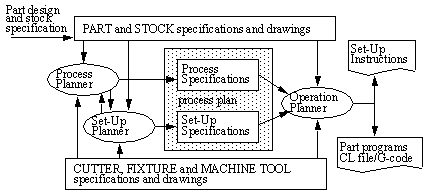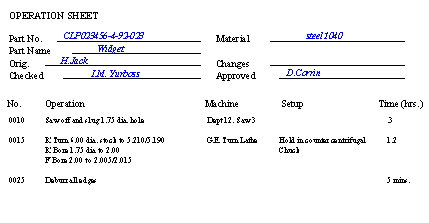1.2 PROCESS PLANNINGA simple job shop, with only a few machines, can do process planning using experience and intuition. But, as the size of the factory grows, and the permutations and combinations of options grows, so does the complexity. This creates a need for specialists called Process Planners who use their experience and detailed knowledge to select the method of production. Requicha and Vandenbrande [1988] describe the task of process planning as: “A process planner and a set-up planner (often the same person) examine a part’s blueprint and consult various files and handbooks to produce a process plan. A plan contains process specifications and information on fixtures and clamping devices to be used, and on set-up of the work-piece on a machine tool. Set-up specifications are typically conveyed through annotated sketches or engineering drawings.” Requicha and Vandenbrande describe the process planning operation as a two step process, as shown in Figure 1.2 Traditional Two-Stage Approach To Process Planning. 
(Adapted from Requicha & Vandenbrande, 1988, pp.302) The first step involves the abstract phases of Process Planning and Set-up Planning. In the second stage, Operation Planning is used to assign details to the operations in the process plan. The final result of process planning can be as shown in Figure 1.3 A Sample of a Process Plan Found in Industry. This sheet emphasizes the ad-hoc nature of data identification, and plan completeness. Many details are cryptic, or must be completed at the machine by the operator. 
The details in a process plan can have a profound impact on the cost of a product and this makes many manufacturers justifiably cautious about change. Employees that do process planning are often long-term employees with a great deal of experience. Companies recognize that it is difficult to capture the knowledge of these individuals. One of the first types of Computer Aided Process Planning (CAPP) systems is generally classified as Variant. These systems ‘look-up’ plans created previously and allow them to be edited to suit new parts. These systems have not replaced the process planner, but they have increased productivity, decreased costs, and reduced mistakes. To date these have been the most successful planners used in industry [Nolan, 1989]. Generative CAPP systems have more potential than the Variant systems, but are still undergoing development within the research community. At their simplest, Generative systems help a designer select operations. More complicated versions promise to fully automate planning. But, to replace the knowledge of a process planner is not a trivial task. Hence, the techniques of Artificial Intelligence (AI) have become very popular in CAPP. Many of the Generative systems are limited to small domains of manufacturing, such as machining, assembly, etc. This is necessary because of the difficulty in capturing knowledge for performing tasks. Systems of restricted production domains are of limited use to a manufacturer. There is a need for a CAPP system is required that plans at a higher level and then, in turn, activates lower level CAPP systems for more detailed planning. Within process planning the source of the plans is the key method of classification. The three basic classifications are Variant, Generative, and Automated [Chang, 1990]. A Variant CAPP system reuses or references standard process plans created previously. Old designs and their plans are recalled by matching abstract codes for the new designs to those of previous designs. The process plan from the old design is then customized for the new design [Nolan, 1989]. In this mode the CAPP system is essentially a plan editing system. This method can be fast to set up, but can be much slower when creating new process plans. In a Generative CAPP system there are no stored plans. Each new plan is created using techniques including dedicated algorithms and Artificial Intelligence. These systems take longer to set up, but are much faster when executing. Nolan [1989] states that these systems have only been successful for very limited cases with well defined planning problems. The third method, as suggested by Chang [1990], is Automated CAPP. This describes a generative CAPP system that runs without operator intervention. Naturally this system is more theoretically demanding, and must have extensive error checking and plan verification functions to replace those of the human planner. This thesis describes a system called BCAPP (Boolean Computer Aided Process Planning) that is capable of planning at a high-level based upon design information. This system looks for clues about which rules (and consequently technologies) are useful. These rules operate on a design stored with Boolean equations of sets, where the sets describe primitive geometries. The planner is not intended to develop all of the detailed operation parameters for the production steps, but it will easily develop high-level plans with mixed production domains. A CAPP module for detailed plans of operations was also created for verification. The interested reader looking for introductory material on Process Planning is directed to Muchnicki [1987], Wang and Wysk [1988] and Nolan [1989]. |